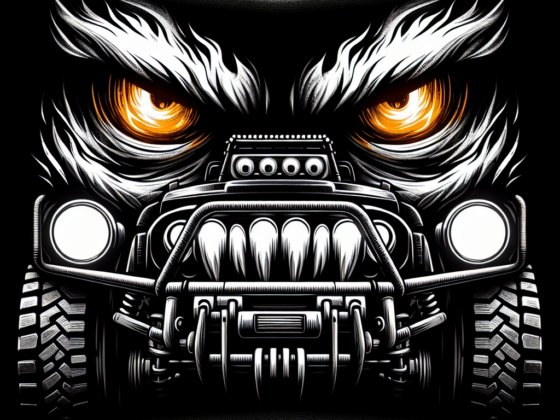So, you’re driving along in your trusty Jeep when suddenly, the dreaded check engine light appears on your dashboard. You can’t help but feel a mix of curiosity and concern – what could be wrong with your beloved vehicle? Well, fear not my friend, because in this article, we’ll explore the common causes behind that pesky check engine light illuminating in your Jeep. From simple issues like a loose gas cap to more complex problems involving the engine itself, we’ll help you understand what might be happening and what steps you can take to resolve the issue. Get ready to tackle that check engine light head-on and get back on the road with confidence.

Understanding the Jeep Check Engine Light
The Importance of the Check Engine Light
The check engine light in your Jeep is an essential safety feature that alerts you to potential issues with your vehicle’s systems and components. It serves as a warning sign, indicating the need for attention and ensuring that you address any underlying problems promptly. Ignoring the check engine light can lead to more significant issues and potentially costly repairs in the long run, so it’s crucial to understand its importance and take it seriously.
Symbols and Colors
When the check engine light illuminates, it’s essential to understand the symbols and colors associated with it. Most Jeep models use a yellow or orange light to indicate a potential problem. The symbol may vary, but it typically resembles an engine, a wrench, or a message like “Check Engine” or “Service Engine Soon.” Familiarizing yourself with the check engine light’s appearance will help you recognize it quickly and take appropriate action.
Common Reasons for Jeep Check Engine Light Illumination
Oxygen Sensor Failure
One common reason for the check engine light to come on in a Jeep is a malfunctioning oxygen sensor. The oxygen sensor helps your vehicle’s engine management system monitor the amount of oxygen in the exhaust gases. A faulty oxygen sensor can lead to decreased fuel efficiency and increased emissions. If your check engine light indicates an oxygen sensor failure, it’s important to have it replaced to ensure optimal engine performance.
Loose or Defective Gas Cap
Another frequent cause of the check engine light illuminating in a Jeep is a loose or defective gas cap. The gas cap plays a crucial role in maintaining the pressure within the fuel system. If the cap is not securely tightened or is damaged, it can trigger the check engine light. Simply ensuring that the gas cap is properly tightened or replacing it if necessary can often resolve this issue and extinguish the check engine light.
Catalytic Converter Dysfunction
A malfunctioning catalytic converter can also trigger the check engine light in your Jeep. The catalytic converter is responsible for reducing harmful emissions by converting them into less harmful substances. If the converter fails, it can lead to increased emissions, reduced fuel efficiency, and potential damage to your engine. Professional diagnosis and replacement of the catalytic converter may be necessary to address this issue.
Spark Plug or Spark Plug Wire Failure
Spark plugs and spark plug wires are vital components of your Jeep’s ignition system. If they become worn out or malfunction, your engine may misfire, resulting in poor performance and increased emissions. Faulty spark plugs or wires can trigger the check engine light, indicating the need for inspection and potential replacement. Regular maintenance and timely replacement of spark plugs and spark plug wires can help prevent check engine light issues related to these components.
Fuel Injector Issues
Fuel injectors play an essential role in delivering the right amount of fuel to your Jeep’s engine for combustion. If the fuel injectors become clogged, dirty, or malfunction, it can lead to a variety of engine problems, including decreased performance and increased emissions. The check engine light can alert you to fuel injector issues, prompting you to have them cleaned or replaced as necessary.
How to Recognize the Seriousness of the Check Engine Light
Blinking vs. Constant Check Engine Light
The seriousness of the check engine light can often be determined by whether it is blinking or constantly illuminated. A blinking check engine light typically indicates a severe issue that requires immediate attention. It often signifies a misfire or other significant engine problem that could lead to engine damage if left unaddressed. On the other hand, a constantly illuminated check engine light may indicate a less critical issue, but it still requires prompt investigation and necessary repairs.
Additional Indicator Lights on Dashboard
In addition to the check engine light, your Jeep’s dashboard may have other indicator lights that provide further insight into the seriousness of the issue. For example, if the check engine light is accompanied by a low oil pressure or high engine temperature warning light, it indicates a potentially critical situation that requires immediate attention. Monitoring other indicator lights can help you gauge the seriousness of the problem and take appropriate action.
Changes in Vehicle’s Performance
Another way to assess the seriousness of the check engine light is by paying attention to any changes in your Jeep’s performance. If you notice a significant decrease in power, rough idling, or difficulty starting the vehicle, it suggests that the issue may be more severe. Changes in fuel efficiency or the presence of unusual noises or vibrations can also indicate a more critical problem. Monitoring your vehicle’s performance can help you determine whether it’s safe to continue driving or if immediate repairs are necessary.
Check Engine Light and Diagnostic Trouble Codes
What are Diagnostic Trouble Codes (DTC)?
Diagnostic Trouble Codes (DTCs) are alphanumeric codes generated by your Jeep’s onboard computer system when it detects an issue with one of the vehicle’s components or systems. These codes provide specific information about the nature of the problem, making it easier for technicians to diagnose and repair the issue. When the check engine light illuminates, it often indicates the presence of one or more DTCs that need to be read and interpreted.
How Jeep Vehicle’s Onboard Computer Generates DTCs
Your Jeep’s onboard computer continuously monitors various sensors and systems to ensure their proper functioning. When it detects a deviation from expected parameters, it generates a Diagnostic Trouble Code (DTC) related to the specific issue. The computer stores these codes in its memory, allowing technicians to retrieve them using specialized diagnostic tools. The presence of a DTC in conjunction with the check engine light can guide technicians towards the underlying problem.
Identifying Common DTCs
Jeep vehicles can generate a wide range of Diagnostic Trouble Codes (DTCs), each corresponding to a specific component or system issue. Some common DTCs related to the check engine light include codes for oxygen sensor failure, catalytic converter dysfunction, misfires, fuel system issues, and several others. The retrieval and interpretation of these codes require the use of an OBD-II scanner or a professional diagnostic tool. Identifying the specific DTCs associated with your check engine light can help you and your mechanic pinpoint the problem quickly and efficiently.

Checking your Jeep’s Health with OBD-II Scanner
Understanding OBD-II Scanner
An Onboard Diagnostics II (OBD-II) scanner is a diagnostic tool designed to read and interpret Diagnostic Trouble Codes (DTCs) generated by your Jeep’s onboard computer. These scanners connect to your vehicle’s OBD-II port, typically located under the dashboard, and retrieve the codes stored in the computer’s memory. OBD-II scanners come in various forms, from handheld devices to smartphone apps, allowing you to check your Jeep’s health and potentially troubleshoot minor issues.
How to Use an OBD-II Scanner
Using an OBD-II scanner is relatively straightforward. Start by locating the OBD-II port in your Jeep, usually under the steering column. Plug the scanner into the port and turn your vehicle’s ignition on without starting the engine. Follow the scanner’s instructions to read the Diagnostic Trouble Codes (DTCs) stored in the computer’s memory. The scanner will provide you with a numerical code and, in some cases, a brief explanation of the issue. Use this information as a starting point for diagnosing and addressing the problem.
Interpreting the Results
Interpreting the results from an OBD-II scanner requires some knowledge of automotive systems and components. Each DTC corresponds to a specific issue, and understanding its meaning can help you identify the problem area. However, keep in mind that an OBD-II scanner provides a starting point for diagnosis rather than a definitive solution. Some codes may require further testing and inspection to pinpoint the root cause accurately. If you’re unsure how to interpret the results, it’s best to seek professional assistance.
Possible Solutions When Check Engine Light Comes On
Perform Regular Jeep Maintenance
Performing regular maintenance on your Jeep is essential to keep it in good working condition and prevent potential check engine light issues. Follow the manufacturer’s recommended maintenance schedule for oil changes, air filter replacements, spark plug inspections, and other routine tasks. Regular maintenance helps ensure that your vehicle’s systems and components are functioning optimally, reducing the likelihood of check engine light illuminations.
Replace Jeep Check Engine Light Component
If the check engine light persists even after identifying and addressing the specific issue, it may be necessary to replace the component related to the illuminated symbol. This could include replacing an oxygen sensor, a catalytic converter, a fuel injector, or other relevant parts. It’s crucial to consult with a qualified mechanic or refer to your vehicle’s service manual to determine the appropriate replacement procedure and ensure the correct installation of the new component.
Professional Assistance Required
In some cases, addressing the check engine light issue may require professional assistance. Complex problems, such as electrical or computer system malfunctions, may necessitate the expertise of a skilled technician who has access to specialized diagnostic tools and knowledge. If you’re not comfortable diagnosing or fixing the problem yourself, it’s always better to seek professional help to avoid further complications or potential damage to your Jeep.

Preventive Measures to Avoid Illumination of Check Engine Light
Regular Vehicle Maintenance
Regular vehicle maintenance plays a significant role in preventing check engine light illuminations. Adhering to your Jeep’s recommended maintenance schedule ensures that your vehicle receives the necessary inspections, tune-ups, and replacements to keep it running smoothly. Stay proactive with tasks such as oil changes, filter replacements, and fluid checks, as neglecting these routine maintenance items can lead to avoidable check engine light issues.
Prompt Attention to Warning Lights
In addition to the check engine light, your Jeep’s dashboard may display other warning lights for different systems or components. It’s crucial to pay attention to these warning lights and address any associated issues promptly. Ignoring warning lights can exacerbate problems and potentially cause more significant damage. When you notice any warning light illuminating, consult your vehicle’s owner manual or seek professional advice to identify and resolve the issue promptly.
Proper Fuel Use
Using the correct fuel for your Jeep is essential to maintain optimal engine performance and minimize the risk of check engine light issues. Follow your vehicle’s fuel recommendations as stated in the owner’s manual. Using the wrong fuel, such as lower octane gasoline in a high-performance engine, can lead to engine knocking, decreased fuel efficiency, and potential damage. Additionally, be cautious when refueling to avoid mixing fuels or accidentally introducing contaminants that could harm your engine.
Regular Engine Check-ups
Periodically inspecting your Jeep’s engine and related components can help identify potential issues before they trigger the check engine light. Look for signs of wear, leaks, loose connections, or unusual noises. Keep an eye on fluid levels, including engine oil, coolant, and transmission fluid, to ensure they are within the recommended ranges. Catching minor problems early on can prevent them from developing into major concerns that trigger the check engine light.
Resetting the Check Engine Light of Your Jeep
Different Methods for Resetting
Resetting the check engine light can be done using various methods, depending on your Jeep model and the underlying issue. One common method is to disconnect the vehicle’s battery for around 15 minutes and then reconnect it. This resets the computer’s memory and clears any stored Diagnostic Trouble Codes (DTCs). Another option is to use an OBD-II scanner to clear the codes manually. However, keep in mind that simply resetting the check engine light does not fix the underlying problem – it merely restarts the monitoring process.
Considerations Before Resetting
Before resetting the check engine light, consider whether the underlying issue has been identified and addressed. If the check engine light has come on due to a minor issue that you have successfully resolved, resetting the light may be appropriate. However, if the cause of the illumination is unknown, it’s best to consult with a professional or conduct further diagnosis to avoid potential complications. Remember that resetting the light will not fix any ongoing issues and may cause the light to reappear if the problem persists.
When to Consult a Professional
While it’s possible to reset the check engine light yourself, there are instances when consulting a professional is recommended. If you have already attempted to resolve the underlying issue and the check engine light continues to illuminate, a mechanic can provide expertise and utilize advanced diagnostic tools to identify the problem accurately. Additionally, if you’re unsure about the cause of the check engine light or lack the necessary knowledge and tools, seeking professional assistance is a wise decision.

Potential Impacts on Vehicle Performance
Impact on Engine Performance
When the check engine light is on, it can have a direct impact on your Jeep’s engine performance. Depending on the underlying issue, you may experience reduced power, rough idling, or difficulty starting the vehicle. Ignoring the check engine light and allowing the problem to persist can lead to more severe engine damage or complete engine failure. Promptly addressing any issues indicated by the check engine light ensures that your engine continues to operate optimally and extends its lifespan.
Impact on Fuel Efficiency
A malfunctioning component or system can significantly affect your Jeep’s fuel efficiency. For example, a faulty oxygen sensor may cause the engine to run rich or lean, resulting in increased fuel consumption. Similarly, issues with spark plugs, fuel injectors, or the catalytic converter can hinder proper combustion and reduce fuel efficiency. Resolving check engine light issues promptly helps maintain optimal fuel efficiency, saving you money at the pump and reducing your environmental impact.
Impact on Vehicle’s Longevity
Neglecting the check engine light and failing to address its associated issues can have long-term repercussions on your Jeep’s overall longevity. Continuously running the vehicle with unresolved problems can lead to premature wear and tear on various components, potentially resulting in costly repairs or even the need for a replacement. Regular maintenance and timely attention to check engine light warnings can help prolong your Jeep’s lifespan and keep it running smoothly for years to come.
Misconceptions about Jeep Check Engine Light
Ignoring the Check Engine Light
One common misconception about the check engine light is that it can be safely ignored. Some drivers mistakenly believe that as long as their vehicle seems to be running fine, the check engine light is not a cause for concern. However, ignoring the check engine light can lead to more significant issues that may compromise your Jeep’s performance, efficiency, and safety. It’s important to address the root cause of the illuminated check engine light to prevent further complications and potential damage.
Relying Solely on OBD-II Scan Tool
While OBD-II scan tools are invaluable for retrieving Diagnostic Trouble Codes (DTCs), they should not be used as the sole diagnostic method. Simply reading and clearing DTCs without further investigation may not provide a complete picture of the underlying problem. Some issues require more thorough inspection and testing to accurately diagnose and resolve. Therefore, it’s crucial to complement the use of an OBD-II scan tool with professional advice or hands-on diagnostics, especially for complex check engine light issues.
Assuming Worst-case Scenarios
When the check engine light illuminates, it’s natural to worry about the potential severity of the problem. However, it’s important not to jump to worst-case scenarios or assume that the issue is catastrophic. While some check engine light issues may indeed be serious, many can be resolved with minor repairs or component replacements. It’s best to remain optimistic and address the problem promptly and methodically, consulting with professionals when needed to obtain accurate diagnoses and appropriate solutions.
In conclusion, understanding the Jeep check engine light is crucial for maintaining the health and performance of your vehicle. By recognizing the importance of the check engine light, familiarizing yourself with common reasons for its illumination, and understanding how to interpret and diagnose Diagnostic Trouble Codes (DTCs), you can address issues promptly and effectively. Taking preventive measures, performing regular maintenance, and seeking professional assistance when necessary will help prevent check engine light problems and ensure your Jeep continues to run smoothly and reliably for years to come.











